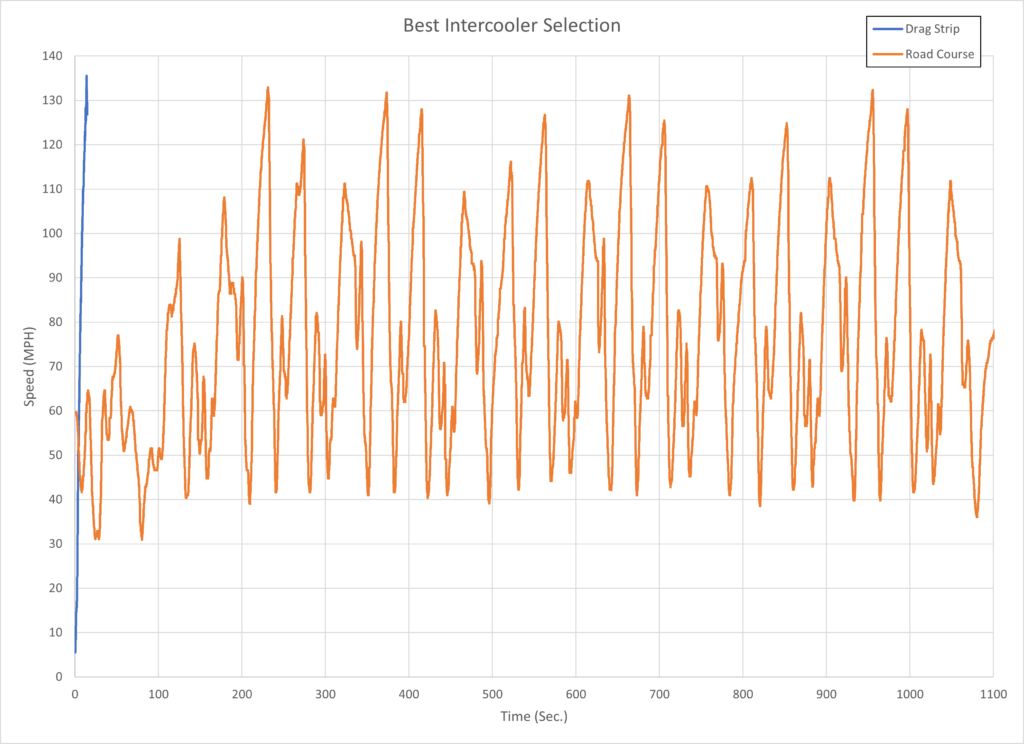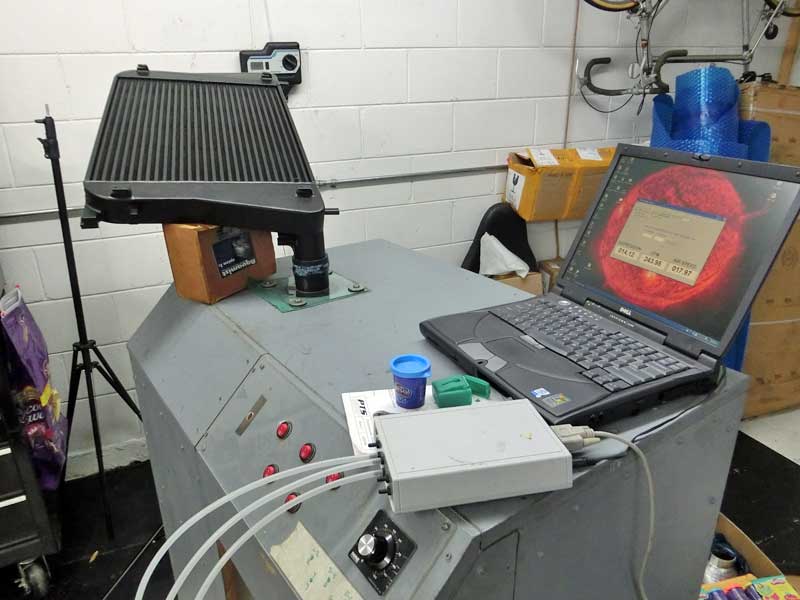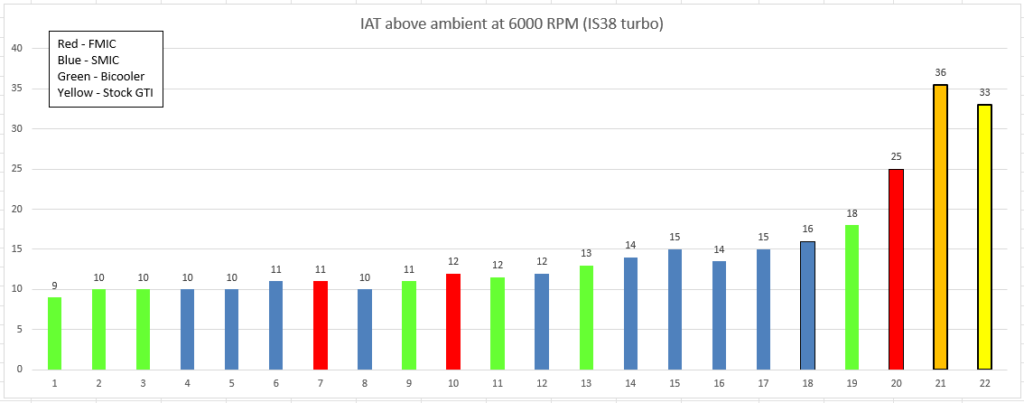Background:
About three years ago I made a post where I offered $400 to the person who could identify the best intercooler for the Mk7 to me.

That money has never been at risk to be paid out.
Lacking useful input to base a decision upon I set out to gather the information I felt would help to answer the question for myself.

Importantly, the information I would collect would be with my GTI, operating in a manner I thought would reflect the conditions I am most interested in. This meant the data was generated using a Shuenk IS38+ turbocharger during a third-gear full-throttle pull with a repeat happening an unspecified time later and for an unspecified number of times.
The operating conditions that an intercooler can be subjected to could vary greatly as shown by the speed versus time chart below. The chart shows two of many possible operating scenarios, the blue line is a car being operated at a drag strip, and the orange line is from a car operating at a road course.

The characteristics of a “best” intercooler are likely to be different for these two operating conditions and it is unlikely any single product will be “best” under both conditions.
Search step one:
The search started with the measurement of airflow through available intercoolers through the use of a flow bench.

Airflow is not the most important consideration when it comes to selecting an intercooler, but if all other factors were equal it would be preferable to have an intercooler that presents minimal pressure drop to the charge air.
Airflow measurements were made first because it is a property that is easy to measure.
Note: I’ve seen comments from others that reference the flow test results as evidence of what IC is the best. This is flawed logic that fails to recognize the primary function of the intercooler is to cool the charge air.
Later, as intercoolers were installed on my GTI I was able to measure the pressure drop on the car. These measurements correlated well with the flow test measurements.
There has been some variation among products but I have not found a significant contribution to vehicle acceleration performance caused by differences in pressure drop with my GTI’s setup.
Search step two:
Measurement of cooling efficiency began as a two-phase process with a bench test performed first.

The goal of the bench testing was to see if a useful correlation could be established with the on-street data recording and as a screening tool to eliminate products that cooled unusually poorly.
Differences between the conditions of the bench test and street testing proved challenging to account for and bench testing was discontinued.
Note: I still come across comments from people referencing the bench cooling testing as an indication of which IC cools the best. This is an incorrect application of the results if they are being used to predict relative cooling performance on the vehicle.
The intake air temperature above ambient read at 6,000 RPM of the third gear pull is the measure of interest from the street logging.
Cooling performance on the street showed similar results from most of the products that have been installed on my GTI as the trend chart below shows:

To account for cooling and pressure drop the products that were measured were placed on a chart where the location on the chart indicates how well the IC performed in each measure.

The temperature measurement is an average, something that is not obvious from the scatterplot format of the data points.
The number in parenthesis is how many samples were averaged. The consequence of being an average is that the comparison is not as clear-cut as the chart could be interpreted as showing. This is more likely when this chart gets taken out of context, such as being re-posted by somebody in a discussion without explanation.
The chart below shows the temperature measurement range for several of the stock location intercoolers. Those that overlap may not have statistically significant differences in performance.

The next chart shows the individual data points for all of the “standard” configurations that have been tested. Importantly, some of the products have many more runs than other products. For example, the Golf R IC has the largest number of runs whereas the TR8L has the fewest.
Generally, more data is better for assessing the true performance of the intercooler. Each dot is a measure of IAT above ambient for the respective intercooler brand.
Note: Non-standard configurations are bicooler pairings such as the do88 with Majesty FMIC. These pairings are not included in the comparison.

Compounding the problem of comparing cooling efficiency is the data collection process. Ambient air temperature factors into how well an intercooler functions. When a data run is recorded relative to others also contributes to the measurement value.
All of these factors contribute to uncertainty in the summary chart.
The comparison is challenged further by the similarity of the performance of the products. The primary factor I’m interested in understanding, the cooling efficiency of a specific intercooler is not significantly different amongst the products tested, which means the contributing factors need to be well-controlled, which is difficult to achieve when driving on the street.
Another important consideration about the similarity of cooling performance is how that translates into vehicle power output. If the difference in cooling performance is 5 degrees Fahrenheit between the “best” and “worst” intercooler, and that equates to a 1 HP difference in power output (speculation), does the difference matter? Might there be some other criteria worth considering? Cost to obtain the product, the weight of the product, ease of installation, ability to easily fit with an aftermarket radiator? Not to mention other performance characteristics.
Status:
With several promising candidate products still untested, such as the PWR, Pro Alloy, and Mabotech stock location ICs, there is insufficient information available to speculate about the “best” intercooler.
If those intercoolers become available for me to test with there will probably still not be a clear-cut best, even by the minimal comparison criteria defined above.
But… but “do88 is the best /“


I bought a Mishimoto intercooler for last year during their Christmas sale for $500. I wanted the do88 but finances were a factor. Fit well, little tight but no alterations were needed. 1 year in, works great, breathes well, and I’ve had zero issues.
It seemed alright from my exposure to it. My main reason for not installing one was the results from when I was heating them on the bench. It continued to put out hotter and hotter air for almost three minutes after I shut off the heat source with the cooling fan on it. I’d like a good balance of absorbing and then eliminating heat from the core.